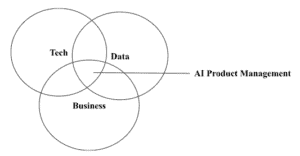ChatGPT has taken the world by storm! Tech influencers and AI enthusiasts are dishing all their knowledge on the topic over social media, especially LinkedIn & Instagram. Thanks to it, everyone now understands what Generative Artificial Intelligence (AI) looks like. Earlier, which was supposed to be a reason for lay-offs, is now seen as a skill.
The world of Product management is no different. Like other industries, it is also evolving and adapting to sync with the fourth industrial revolution. AI has found a place in our lives, from driving cars to playing songs. But how exactly is the product industry catering to this addition?
Palarino Partners, a product manager recruiting agency, developed this blog to answer this question. Here we will explore the basics of AI Product management and which skills will help aspiring product managers land their dream jobs in the AI era.
What is AI Product Management?
Every typical blog about product management begins with a Venn Diagram showing an intersection of three domains: UX, Tech & Business. Following the same approach, AI Product Management can be conceptualized as:
To understand the above diagram, let’s take the example of Netflix.
So, which is the first thing that any user will like about Netflix— an extensive list of genres, the convenience of watching any movie at home, or the content quality?
Though there will be multiple answers, most will point toward the content, thanks to Netflix’s recommendation system.
AI helped Netflix take hold of the market at the right time by suggesting to the viewers’ what to watch.’ If we go by the rule of marketing, it influences the audience to click and watch the content that the platform desires. The crux here is that the system works by showing what the viewer would like to see.
For this, the digital platform analyzes the user behavior and tries to identify the pattern. Then, it gives the viewers the freedom to choose from the personalized list and the suggestions related to top shows/movies on a specific day arranged in order from 1 to 10.
In short, the use of data is at the core of AI.
This brings us to our definition of AI Product Management, which can be summarized as managing technology, data, and business processes, to develop, launch, and operate AI products.
Who is an AI Product Manager (PM)?
Like other product managers, the role played by a PM in the AI sector is no different. Their aim here, too, is linked with value generation in consumer goods. They try to build, improve, and earn revenue from digital products.
Big firms introduced AI features at such a large scale that even the app you are using right now to read this blog is a product of multiple discussions and iterations of teams led by Product Managers.
Simply put, the Product Manager who uses AI and machine learning (ML) to create, improve, and shape product designs that better resonate with the users’ requirements and brand goals is an AI product manager.
Understanding the Roles & Responsibilities of AI Product Manager
With the rising demand for technical professionals and product leads, Large IT firms are hiring the right people to accelerate their product development process. Therefore, anyone wanting to enter the workforce as an AI product manager must understand the job description to prepare for the product manager interview questions correctly.
Focus on the Bigger Picture with AI
While it’s a no-brainer that PMs have to conduct research and develop compelling product visions, the addition of AI is.
Here you need to identify the opportunities where advanced analytics, AI, and ML can solve specific user problems that scale in the long term. Apart from creating a roadmap, you must incorporate best data science practices to stay relevant to the times and dynamic user behavior.
Use Data Insights to Manage Product Backlog
Every product idea begins with Data. It was information that innovated ‘Siri’ and ‘Alexa.’ It was effectiveness and accuracy that brought ‘Grammarly.’ In other words, PMs must leverage data insights at every stage of product development, especially to clear backlogs.
Start listing product ideas that align with your target market and goals. Use prioritization to determine which plan needs to go first and get the team on the table. Once the consensus is reached, look at significant voids your product can bridge now and in the future.
Also, never restrict any product team from experimenting. If their trials are relevant to the industry and can bring a revolutionary change, analyze how much resources you can devote and the potential risks involved.
Monitor & Track Product Development Process
The best way to develop a scalable product is to keep tabs on the processes. Identify which business model your team will use and how. Gain clarity about your business outcomes and decide the key metrics you will utilize to track the success of different products.
When working with diverse teams, it’s imperative to understand their viewpoints on product performance. It gives you an edge and helps you make better decisions.
Create a Campaign & Launch the Product
Marketing is a crucial part of every Product Management Organization. Call it a must-have ingredient or the secret sauce of successful product launches, but your campaign determines your product’s success.
Moreover, your company needs better ways to reach consumers with AI products, and effective marketing is vital. That means simply creating won’t help; you need creativity. Make compelling Ads and let your consumers know how a specific AI product can make their life easier.
Measure the Success at Different Phases
Every stage has its success metrics and risks. So, determine which phase can give the most trouble and try to reduce the damage using the right strategies. The goal here is to keep the revenue graph increasing without any dips.
However, measuring success is more than calculating revenue. Apart from estimating the monetary gains, PMs also need to figure out the scope of improvement in existing products. For example, an e-commerce website with an unclear CTA can be further improvised with clear design elements so the customers know where to click next.
Customer feedback forms and surveys can help you with this. You can also ask for suggestions they would like to see in the existing technology, so your team can work accordingly.
Key Takeaways
The product market is more dynamic than before. Here, trends change almost every other day. Therefore, as a future AI product manager, you must understand the tech market’s ins & outs. It helps you develop future-ready products that scale.
Explore our blog section for more information on the product manager’s role.









